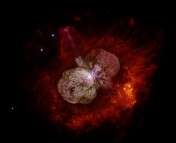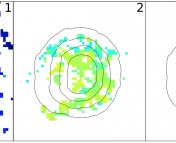Title: Gamma-ray burst supernovae as standardizable candles
Authors: Z. Cano
First Author’s institution: Centre for Astrophysics and Cosmology, Science Institute, University of Iceland, Reykjavik, Iceland.
Gamma ray bursts (GRBs) are among the most energetic and explosive events in the Universe. Although the exact mechanism underlying a GRB is still uncertain, it has been proposed that these explosions are the result of a black hole forming in the midst of a collapsing star, and the resulting outflowing jets producing gamma rays through collisions with intervening stellar material. Many GRB events are also observed to occur with a companion supernova (also known as a hypernova). These GRB-SNe pairs hint that there may be a common physical mechanism powering these types of events.
Objects such as Type Ia supernovae have traditionally served as standard candles for distance measurements due to their relatively predictable luminosities. Given their extraordinarily large luminosities, abundance, and cosmological distances, GRBs might also seem to be good standard candles. However, the irregularity of GRB light curves have excluded these objects from being used as standard candles in the past. In contrast, the light curves of Type Ia supernova are remarkably consistent, and there are well constrained relations between these light curves and the intrinsic luminosity of the explosion.
This paper looks at eight different GRB-SNe events. To examine the consistancy of these light curves across these GRBs, the author calculates a luminosity parameter (denoted k) and a width/shape parameter (denoted s) of these GRB-SNe light curves relative to a template SNe light curve (SN 1998bw). This is done after correcting for extinction along the line of sight and subtracting the emission from the host galaxy. By doing a best fit and performing a correlation analysis between k and s, the paper finds that there is a statistically significant correlation between the two (Fig. 1). The author also examines an additional GRB without a supernova counterpart, and finds that this event has k and s parameters that also fit into the correlation. However, given that this is just a single data point, it is difficult to draw any conclusions about the applicability of this correlation towards GRBs without corresponding SNe.

Fig. 1: A correlation between the luminosity (k) and stretch (s) factors of the GRB-SNe pairs examined in this paper. The colors indicate data taken in different color filters, and the dashed line indicates the uncertainty of the best-fit line. The histograms on the bottom show the distribution of the best-fit parameters from a Monte Carlo simulation.
The author suggests that there may be a physical explanation behind this correlation. Since the gamma rays in a GRB are produced in beamed, relativistic jets, we are viewing these GRB-SNe pairs from the same orientation (i.e. along the jets). Hence, the correlation between luminosity and light curve shape might arise from the fact that the ejecta geometry is similar across objects. This correlation could also suggest some sort of connection between the luminosity of the explosion and nucleosynthesis mechanisms: since the light curves of GRB-SNe events are additionally powered by the radioactive decay of 56-Ni decaying into 56-Fe (which also has some consistency across different events), the similarities in the physics between Type Ia SNe and these GRB-SNe pairs could indicate why the latter might be useful as standard candles.
In summary, this correlation between the brightness and shape of a GRB light curve suggests that there is some promise for GRBs to be used as standard candles. However, given the small sample size used in this study, it is difficult to make generalizations about the applicability of this method. To test this idea further, more observations of GRB-SNe pairs are needed in the future.




